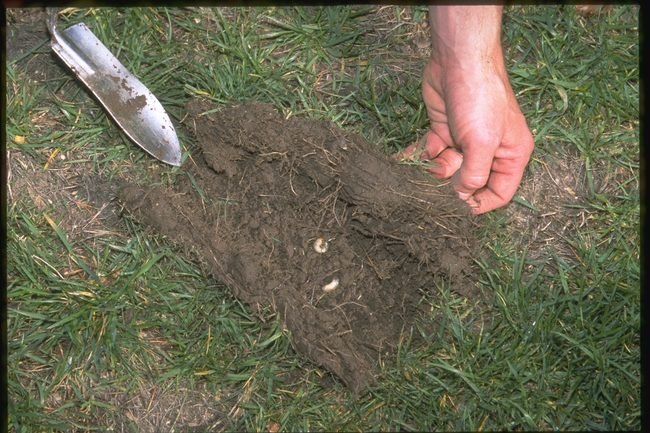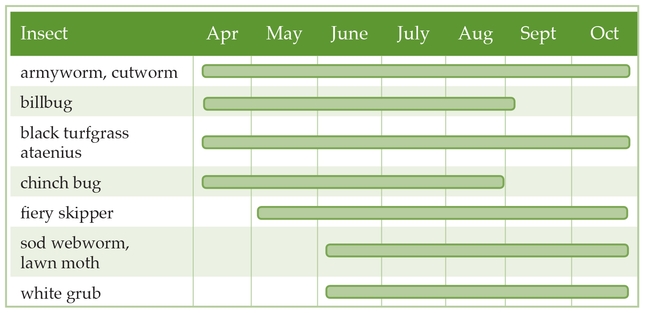[From the May 2015 issue of the UC IPM Green Bulletin]
Figure 1. Patch of turfgrass killed by billbugs.
Pest management for turf areas begins during the design and installation of the site, with species selection, grading and drainage, irrigation systems, and the maintenance plan. Choosing the appropriate turf species for the site by considering regional climate and water availability is the single best way to reduce overall stress and to ensure longevity and resiliency of the grasses planted. The University of California's Division of Agriculture and Natural Resources (UC ANR) has published some excellent online resources to help choose appropriate turf species based on tolerance to key stressors such as temperature, salinity, drought, and foot traffic.
Once established, turf needs to be properly managed for health, considering aspects such as mowing height, appropriate watering and drainage, and periodic thatch removal. Thatch removal can be especially important since many pests take shelter in thatch and because monitoring is more difficult when thatch has built up.
Figure 2. Performing a drench test.
Figure 3 Pull back turf to inspect root zone.
Often times, damage due to insect pests in turf only becomes apparent during late summer and fall, when low soil moisture and heat stress take a visible toll on areas with damaged roots or tattered blades. Unfortunately, it is difficult or even impossible to mitigate the damage at this point since pests may already be gone or dormant and because grasses are no longer vigorously growing. For example, the larvae of masked chafers (the most common and most damaging of the ‘white grub' species, having only one Figure 4 Masked chafer larvae (white grubs).
Learn more about prevention, monitoring, and treatment of turf pests by accessing UC IPM's newly revised Lawn Insects Pest Note.
![Figure 1. Patch of turfgrass killed by billbugs. [J.K. Clark, UC IPM] Figure 1. Patch of turfgrass killed by billbugs. [J.K. Clark, UC IPM]](http://ucanr.edu/blogs/UCIPMurbanpests/blogfiles/29477.jpg)
![Figure 2. Performing a drench test. [J.K. Clark, UC IPM] Figure 2. Performing a drench test. [J.K. Clark, UC IPM]](http://ucanr.edu/blogs/UCIPMurbanpests/blogfiles/29478.jpg)

![Figure 4 Masked chafer larvae (white grubs). [J.K. Clark, UC IPM] Figure 4 Masked chafer larvae (white grubs). [J.K. Clark, UC IPM]](http://ucanr.edu/blogs/UCIPMurbanpests/blogfiles/29482.jpg)
